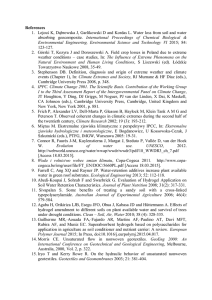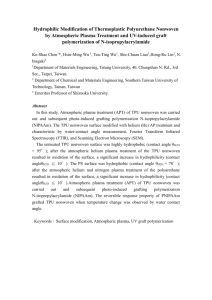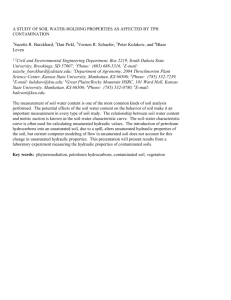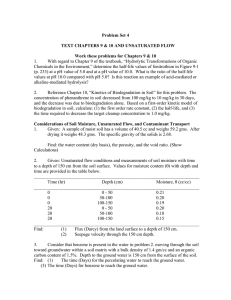Optimisation of Operational Parameters for Nonwoven Sheaths of Water Absorbing
advertisement
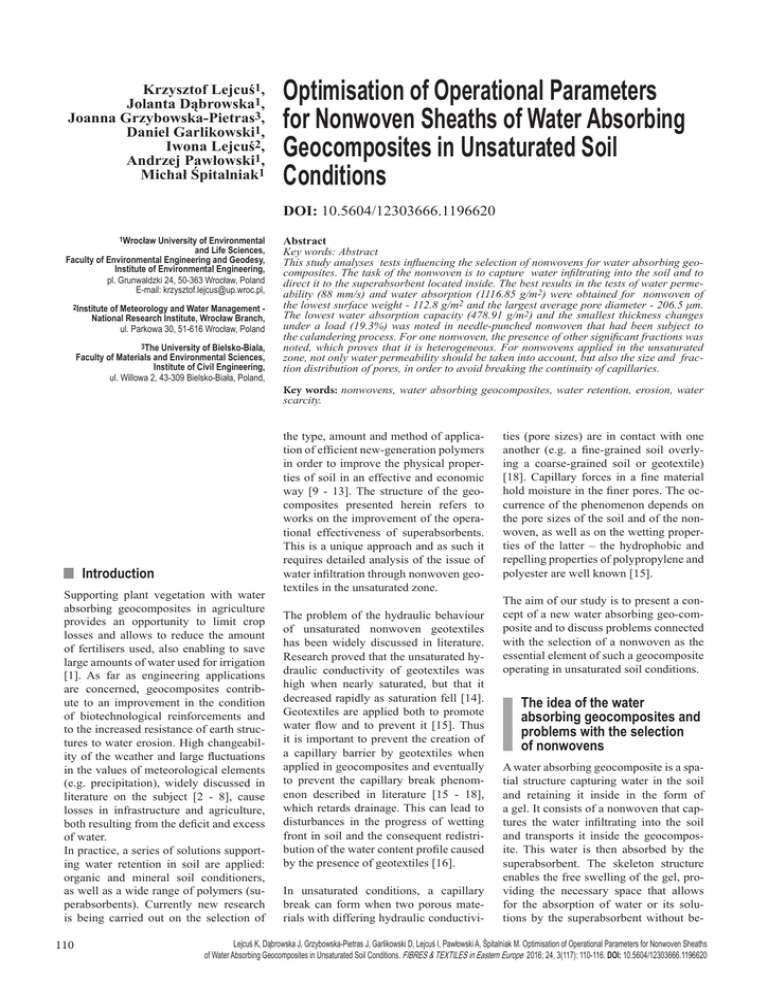
Krzysztof Lejcuś1, Jolanta Dąbrowska1, Joanna Grzybowska-Pietras3, Daniel Garlikowski1, Iwona Lejcuś2, Andrzej Pawłowski1, Michał Śpitalniak1 Optimisation of Operational Parameters for Nonwoven Sheaths of Water Absorbing Geocomposites in Unsaturated Soil Conditions DOI: 10.5604/12303666.1196620 1Wrocław University of Environmental and Life Sciences, Faculty of Environmental Engineering and Geodesy, Institute of Environmental Engineering, pl. Grunwaldzki 24, 50-363 Wrocław, Poland E-mail: krzysztof.lejcus@up.wroc.pl, 2Institute of Meteorology and Water Management - National Research Institute, Wrocław Branch, ul. Parkowa 30, 51-616 Wrocław, Poland 3The University of Bielsko-Biala, Faculty of Materials and Environmental Sciences, Institute of Civil Engineering, ul. Willowa 2, 43-309 Bielsko-Biała, Poland, nIntroduction Supporting plant vegetation with water absorbing geocomposites in agriculture provides an opportunity to limit crop losses and allows to reduce the amount of fertilisers used, also enabling to save large amounts of water used for irrigation [1]. As far as engineering applications are concerned, geocomposites contribute to an improvement in the condition of biotechnological reinforcements and to the increased resistance of earth structures to water erosion. High changeability of the weather and large fluctuations in the values of meteorological elements (e.g. precipitation), widely discussed in literature on the subject [2 - 8], cause losses in infrastructure and agriculture, both resulting from the deficit and excess of water. In practice, a series of solutions supporting water retention in soil are applied: organic and mineral soil conditioners, as well as a wide range of polymers (superabsorbents). Currently new research is being carried out on the selection of 110 Abstract Key words: Abstract This study analyses tests influencing the selection of nonwovens for water absorbing geocomposites. The task of the nonwoven is to capture water infiltrating into the soil and to direct it to the superabsorbent located inside. The best results in the tests of water permeability (88 mm/s) and water absorption (1116.85 g/m2) were obtained for nonwoven of the lowest surface weight - 112.8 g/m2 and the largest average pore diameter - 206.5 μm. The lowest water absorption capacity (478.91 g/m2) and the smallest thickness changes under a load (19.3%) was noted in needle-punched nonwoven that had been subject to the calandering process. For one nonwoven, the presence of other significant fractions was noted, which proves that it is heterogeneous. For nonwovens applied in the unsaturated zone, not only water permeability should be taken into account, but also the size and fraction distribution of pores, in order to avoid breaking the continuity of capillaries. Key words: nonwovens, water absorbing geocomposites, water retention, erosion, water scarcity. the type, amount and method of application of efficient new-generation polymers in order to improve the physical properties of soil in an effective and economic way [9 - 13]. The structure of the geocomposites presented herein refers to works on the improvement of the operational effectiveness of superabsorbents. This is a unique approach and as such it requires detailed analysis of the issue of water infiltration through nonwoven geotextiles in the unsaturated zone. The problem of the hydraulic behaviour of unsaturated nonwoven geotextiles has been widely discussed in literature. Research proved that the unsaturated hydraulic conductivity of geotextiles was high when nearly saturated, but that it decreased rapidly as saturation fell [14]. Geotextiles are applied both to promote water flow and to prevent it [15]. Thus it is important to prevent the creation of a capillary barrier by geotextiles when applied in geocomposites and eventually to prevent the capillary break phenomenon described in literature [15 - 18], which retards drainage. This can lead to disturbances in the progress of wetting front in soil and the consequent redistribution of the water content profile caused by the presence of geotextiles [16]. In unsaturated conditions, a capillary break can form when two porous materials with differing hydraulic conductivi- ties (pore sizes) are in contact with one another (e.g. a fine-grained soil overlying a coarse-grained soil or geotextile) [18]. Capillary forces in a fine material hold moisture in the finer pores. The occurrence of the phenomenon depends on the pore sizes of the soil and of the nonwoven, as well as on the wetting properties of the latter – the hydrophobic and repelling properties of polypropylene and polyester are well known [15]. The aim of our study is to present a concept of a new water absorbing geo-composite and to discuss problems connected with the selection of a nonwoven as the essential element of such a geocomposite operating in unsaturated soil conditions. The idea of the water absorbing geocomposites and problems with the selection of nonwovens A water absorbing geocomposite is a spatial structure capturing water in the soil and retaining it inside in the form of a gel. It consists of a nonwoven that captures the water infiltrating into the soil and transports it inside the geocomposite. This water is then absorbed by the superabsorbent. The skeleton structure enables the free swelling of the gel, providing the necessary space that allows for the absorption of water or its solutions by the superabsorbent without be- Lejcuś K, Dąbrowska J, Grzybowska-Pietras J, Garlikowski D, Lejcuś I, Pawłowski A, Śpitalniak M. Optimisation of Operational Parameters for Nonwoven Sheaths of Water Absorbing Geocomposites in Unsaturated Soil Conditions. FIBRES & TEXTILES in Eastern Europe 2016; 24, 3(117): 110-116. DOI: 10.5604/12303666.1196620 ing affected by the stress resulting from the load of soil above it. This space enables to fully benefit from the properties of superabsorbents. Superabsorbents are usually applied in agriculture in a loose form and are directly mixed with soil. Unfortunately due to the load caused by the soil deposited above them. they cannot absorb water freely, which leads to a significant decrease in their capacity. At the same time, if they are placed in the superficial layer of soil, where the load is small, after swelling they may be transported to the surface of the soil. On a slope the direct method of application can cause stability problems because strength parameters of soil are negatively influenced by the presence of the SAP in the pores between grains [19]. After the absorption, the water retained inside the gel is available for plants, which can freely grow through the nonwoven and collect the water from the superabsorbent due to the suction forces of roots. The process of retaining and collecting water can occur repeatedly. A skeleton structure from natural or synthetic material can be formed from a mesh, geogrid, perforated tapes, spatial drainage mats, woven fibres and wires. A natural material can be willow shoots or hemp, or coconut fibre, and the synthetic material can be, for example, polyethylene. The sheath may consist of a nonwoven or fabric made from synthetic or natural material. The materials most commonly used in the construction of geocomposites are polypropylene or polyester nonwovens of a basic weight not exceeding 350 g/m2, produced from section fibres by mechanical needle-punching (or with the use of the spun-bonded technique). As a result of needle punching, steel needles with cuts pull the fibres perpendicularly to the surface of the fleece, creating a spatial arrangement of fibres and interlocking (intertwining) them. As a result, a three dimensional structure characterised by specific mechanical and hydraulic properties emerges. The most important factors influencing the resulting properties of geotextiles are the following: the geometric dimensions of the fibres applied (also called the morphological structure of the fibre – such as the type of raw material used, the length and width of the fibre, the expansion of the surface and cross-section) and the parameters of the needle punching process, including FIBRES & TEXTILES in Eastern Europe 2016, Vol. 24, 3(117) Figure 1. Variant of point geocomposite (photo: J. Dąbrowska). Figure 2. Variant of geocomposite in the form of a spatial mat. the number of punches per 1 cm2 of surface and the depth of punching. Sample solutions for the construction of water absorbing geocomposites are shown in Figures 1 and 2. The absorbing material is a superabsorbent (hydrogel), or another material characterised by similar properties, that has the capacity to retain water and its solutions [20]. Geocomposites, depending on their form and size, are designed for ornamental potted plants, trees and shrubs in horticulture, orchardry, forestry, in urban green areas, for plants adjacent to soundproof screens and in specialised applications, e.g. in the construction of green walls, green roofs, for Bonsai trees and orchids. They are used in environmental engineering to support the vegetation of turf as an anti-erosion protection for road and motorway slopes, flood embankments, slopes of landfills and to support plant vegetation in the recultivation of degraded areas. Geocomposites are available in a wide selection of sizes and shapes: small mats (5 cm long, 3 cm wide and 0.5 cm thick) for Bonsai trees, cylinders of a diameter and height of 5 cm and higher for potted plants, linear geocomposites up to 1 m long and 5 - 15 cm wide and thick for trees and vines, and 2 - 4 cm thick mats for engineering applications. A new geosynthetic has been developed at Wrocław University of Environmental and Life Sciences [21]. Initial research on the efficiency of capturing water by geocomposites in soil profiles in a standard laboratory and field conditions showed that when different types of nonwovens of similar hydraulic properties were used to create the geocomposites, significant differences were obtained in the transmission of the infiltrating water into the superabsorbent inside the geocomposite, and in some cases, only for certain nonwovens, there was a total lack of water transmission, in spite of intense spray irrigation. Such a difference was observed for the N1 nonwoven analysed for the purposes of this study, characterised by the highest pore size distribution and water permeability of the 5 materials tested. Differences were noticeable for fine-grained soils. For sands no water flow problems were detected. The authors concluded that the problems resulted from the interrupted permanence of the capillary above the geocomposite; water flowed around the geocomposite through those capillaries that were not broken. Analysis of the literature proved the occurrence of problems characteristic for unsaturated conditions. For a nonwoven operating as a geocomposite sheath in unsaturated 111 the following parameters: mass per unit area (PN-EN ISO 9864:2007), thickness (PN-EN ISO 9863-1:2007), and tensile strength (PN-EN ISO 10319:2010). The hydraulic properties were characterised by the water permeability (PN-EN ISO 11058:2011), water absorption (PNP-04734:1972) and pore size distribution [25 - 29]. soil-water zone zone of aeration capilary zone water table water absorbing geocomposite zone of saturation Figure 3. Geocomposite element applied to soil. Table 1. Physical parameters of nonwovens tested; S – Sample standard deviation, V- coefficient of variation. Needle- punched nonwovens Mass per unit area, g/m2 Thickness under load of 2 kPa, mm Thickness under load of 20 kPa, mm Thickness under load of 200 kPa, mm 100% PET More than Statistical 100% PET 100% PET 100% PP +calandering 95% PET parameters N1 N2 N3 N4 N5 x 112.80 215.60 179.60 197.20 138.00 S 5.60 2.33 10.23 4.12 7.04 V [%] 4.96 1.08 5.70 2.09 5.10 x 1.43 1.63 2.53 1.14 1.85 S 0.09 0.05 0.09 0.08 0.04 V [%] 6.12 2.99 3.64 7.21 2.26 x 0.82 1.14 1.61 0.96 0.92 S 0.07 0.03 0.07 0.05 0.04 V [%] 9.09 2.65 4.57 4.91 4.32 x 0.61 0.84 1.06 0.92 0.75 S 0.05 0.03 0.03 0.02 0.02 V [%] 8.15 3.32 2.89 2.38 2.86 conditions, the main factors are good water permeability and the ability to prevent capillary break phenomena. Clogging is a much less significant threat in the unsaturated zone [22, 23] Water absorbing geocomposites operate in the unsaturated (unsaturated) zone above the ground water surface (Figure 3). During usage, the covering nonwoven is subject to numerous cycles of drying and soaking. As its task is to capture water infiltrating into the soil, it 20 kPa n Research methodologies Physical and mechanical properties of the nonwovens were characterised by 200 kPa 3.0 100 2.5 90 2.0 1.5 1.0 The Kruskal-Wallis non-parametric test was used for thickness-under-load data to investigate possible differences in results at the α = 0.05 level of significance. Statistical analyses were conducted with the use of the software package Statistica v. 10. 20 kPa 200 kPa 80 70 60 0.5 0.0 50 N1 N2 N3 N4 N5 Figure 4. Influence of the type of nonwoven and initial load on the thickness of the nonwoven. 112 Four needle punched nonwovens made from hydrophobic materials (PET, PP) and one needle-punched nonwoven that had been subjected to calandering (PET), with a surface weight lower than 350 g/m2 and declared high water permeability were selected for the tests. The fibre diameter in all nonwovens tested falls into the range from 18 to 22 μm. The scope of load selected for test purposes takes into account the application of geocomposites under a loaded and non-loaded layer of soil. 2 k Pa Porosity, % Thickness, mm 2kPa should transmit it vertically downwards. The hydraulic properties of nonwovens in the design standards and methods of testing geotextiles applied are determined based on the assumption of saturated conditions [24], while those properties are different in unsaturated conditions. Moreover in order to determine the size and fraction distribution of pores, measurements were taken with the use of a PMI capillary porometer (Porous Materials, Inc. USA). A capillary porometer determines the porosity of nonwovens by means of measuring the size of the largest pores, the mean size of pores and the curve characterising the share of fractions of pores of a specific size range. The determination of these three properties of porosity allows for sufficiently accurate characteristics of the nonwoven structure in the aspect of filtration material properties [30, 31]. N1 N2 N3 N4 N5 Figure 5. Porosity of nonwoven under load. FIBRES & TEXTILES in Eastern Europe 2016, Vol. 24, 3(117) Needle-punched nonwovens N1 and N5 have a surface weight lower than 150 g/m2, while the highest surface weight, 215.60 g/m2 , was noted in polyester needle-punched nonwoven N2 (Table 1). Tests of the influence of a load on the thickness of the nonwovens analysed at a defined load (Figure 4) demonstrated that at an initial load of 2 kPa the highest thickness of 2.53 mm was noted in the needle-punched nonwoven made of 100% from PP fibres (N3), and the lowest thickness in needle-punched non-woven from 100% PET that had been subjected to the calandering process (N4), where the parameter value analysed was 1.14 mm. One can easily notice that the differences in nonwoven thickness start to blur with an increase in the load. At a load of 200 kPa the highest, similar reduction in thickness in comparison to initial values, regardless of the surface mass and composition, was noted for samples N1 (57.3%), N3 (58.1%) and N5 (59.5 %). As a result of the calandering of needle-punched nonwoven 100% PET (N4), the reduction in thickness caused by an increased load is only 19.3%. The test results obtained were subject to statistical analysis with the use of the Kruskal-Wallis test, which proved that the changes in thickness of all nonwovens under a load were statistically significant. For α = 0.05, a p-value in the range 0.006 - 0.002 was obtained. Analysis of thickness changes under the influence of a load is very important as nonwoven acting as filtration material is installed and covered with soil. An increased load causes a reduction in the thickness of the fabric and an increase in its apparent density, which may have a negative influence on the value of water permeability normal to the plane. Analysis of the nonwoven porosity results under loads of 2, 20 and 200 kPa (Figure 5) demonstrates that with an increase in the load the porosity of the fabrics becomes similar, regardless of the surface mass and initial thickness, falling into the range from 85.05% (N4) to 86.73% (N5). It should be noted here that the porosity is closely connected with the fibre packing density in the given volume of nonwoven, which is essential for evaluation of the hydraulic properties of the material. FIBRES & TEXTILES in Eastern Europe 2016, Vol. 24, 3(117) Table 2. Hydraulic parameters of nonwovens tested; S – Sample standard deviation, V- coefficient of variation. Needle- punched nonwovens Water permeability characteristics normal to the plane. without load, mm/s Water absorption, g/m2 Porosity under load of 2 kPa, % Porosity under load of 20 kPa, % Porosity under load of 200 kPa, % 100% PET More than Statistical 100% PET 100% PET 100% PP +calandering 95% PET parameters N1 N2 N3 N4 N5 x 88.0 71.80 76.10 74.0 S 3.60 5.30 4.20 3.00 7.0 V, % 4.10 7.71 5.52 4.34 8.59 79.0 x 1116.85 637.66 926.92 478.91 1314.09 S 52.4 26.51 74.32 37.22 100.3 V, % 4.69 4.16 8.02 7.77 7.63 x 94.28 90.43 92.44 87.42 94.58 0.12 S 0.34 0.29 0.28 0.90 V, % 0.36 0.32 0.30 1.03 0.13 x 89.95 86.24 88.12 85.05 89.09 0.50 S 0.93 0.37 0.54 0.74 V, % 1.03 0.42 0.61 0.87 0.56 x 86.47 81.47 81.93 84.46 86.73 S 1.10 0.61 0.53 0.37 0.38 V, % 1.27 0.75 0.64 0.44 0.44 Results of the determination of water absorption of the nonwovens analysed (Table 2) are also interesting. For needle-punched nonwovens of the lowest surface weight: N1 (100% PET) and N5 (over 95% PET) water absorption exceeds 1000 g/m2 and amounts to 1116.85 g/m2 and 1314.09 g/m2, respectively. An almost twofold increase in the surface weight of the nonwoven (N2) led to a 50% reduction in water absorption (637.66 g/m2). The lowest water absorption capacity was noted in needle-punched nonwoven that had been subjected to the calandering process (478.91 g/m2). Water absorption converted into g/g (gram of water per gram of the sample) was as follows: 9.90 for N1, 2.96 for N2, 5.16 for N3, 2.43 for N4 and 9.52 for N5. Here the highest values were also noted for N1 and N5 nonwovens. The best results in the tests of water permeability normal to the plane without a load were obtained for the nonwoven of the lowest surface weight N1, the worst in N2 and N4; for the N4 that had been subjected to calandering (Figure 6). The appropriate size of pores in the nonwoven has a significant influence on the efficiency of geocomposites. The nonwoven sheath should be characterised by high water permeability and at the same time resistance to capillary break phenomena. Both Table 3 and diagrams of pore fraction distribution shown in Figure 7 demonstrate that in the case of needlepunched nonwoven N1 100% PET the main fraction of pores of the mean substitute diameter falls into a very narrow range from 201.7 μm to 212.8 μm. 0.06 0.05 Hydraulic head, m n Results and discussion 0.04 0.03 0.02 0.01 N1 N2 N3 N4 N5 0 0 0.02 0.04 0.06 0.08 0.1 0.12 Flow velocity, m/s Figure 6. Influence of the type of nonwoven on water permeability normal to the plane. 113 60 40 20 0 0 50 PorePore size sizedistribution distribution 150 200 250 300 350 Average Averagediameter, diameter, mmmm N1 80 60 40 20 0 0 50 100 150 100 80 60 40 20 0 0 50 200 250 300 350 Average diameter, mm Average diameter, mm 150 200 250 300 350 300 350 Average diameter, mm Average diameter, mm 100 80 60 40 20 0 0 50 100 150 200 250 Average diameter, Average diameter, mm mm N4 100 80 60 40 20 0 0 50 N5 100 150 200 250 300 350 Average diameter, mm Average diameter, mm The bubble point [32] in the nonwoven analysed equals 252.3 μm. Apore fraction distribution test results for nonwovens N2 (100% PET) and N4 (100% PET + calandering) enables to notice a shift in the main pore fraction towards lower sizes of 58.2 - 63.4 µm. These samples do not have other significant pore fractions. In the context of the literature analysis conducted, this explains the differences in their effectiveness in the unsaturated zone. The selection of geotextiles to be applied in the unsaturated zone should be based both on the size and homogeneity of the nonwoven pores and the soil. The diameter of capillaries in the soil where the nonwoven is to be applied is influenced mainly by the grain size dis- Figure 7. Influence of manufacturing technology on the fraction distribution of pores in the nonwoven. tribution and degree of compaction. Due to the difficulties in determining the diameter of capillaries in the soil, the best method of testing the selection of a nonwoven for a specific type of soil proved to be the experimental method – in soil profiles or filtration columns. Further research is required in order to determine the specific correlations between the values characterising the pore sizes in soil and geotextiles and the occurrence of the capillary break phenomenon. Analyses of the effectiveness of water absorbing geocomposites were conducted for various types of soils and horticultural substrates on a laboratory scale and in the field, with the use of nonwovens of optimum parameters selected following the results of studies presented herein. The possibility to limit the amount Table 3. Fraction distribution of pores in the nonwoven. Needle- punched nonwovens Sample Bubble point, μm 100% PET N1 252.3 201.7 – 212.8 100% PET N2 735.1 45.5 – 61.3 58.2 100% PP N3 321.8 99.1 – 106.9 103.9 100% PET +calandering N4 288.5 60.5 – 66.4 63.4 more than 95% PET N5 357.9 178.5 – 211.4 196.6 114 100 N2 100 N3 Pore distribution Poresize size distribution 100 PorePore size sizedistribution distribution 80 Pore size distribution Pore size distribution PorePore size sizedistribution distribution 100 Pore size distri- Average dia- Other significant bution, μm meter, μm fractions, μm 206.5 – 47.9 of water used in plant cultivation and the high efficiency of geocomposite in water saving in sandy and clayey soils are discussed in the study by Lejcuś at al. [1]. The findings include, among others, the beneficial influence of geocomposites on the increase in the grass root volume by 130%, the root length by up to 29%, the mass of the overground parts of plants by 83%, an the shearing strength of the layer of soil overgrown by roots by 20% for grass and by 66% for shrubs [33]. Geocomposites also have a positive influence on vegetative growth and the flowering of ornamental plants [34]. The selection of nonwovens for geocomposites, also in other cases of applications in the unsaturated zone, e.g. landfill covers, agricultural applications, should take into consideration the fact that the hydraulic properties of geosynthetics in the unsaturated zone are different from those in the saturated zone. In order to avoid a capillary break, experimental tests should be used. The selection of an inappropriate geotextile in landfill covers may result in a failure – water retained in the soil profile constitutes an additional load that affects the stability of the slopes [35]. New geotextiles are being created FIBRES & TEXTILES in Eastern Europe 2016, Vol. 24, 3(117) for applications in the unsaturated zone – wicking geotextiles made from wicking nylon fibres with a unique cross-section, which eliminate the problem of the capillary barrier [18]. nConclusions The results of the analysis of the properties of nonwoven geotextiles showed that nonwovens of similar (very high) water permeability and porosity - N1 and N5 have some different characteristics connected with pore size. For N1 the main fraction of pores is 201.7 - 212.8 μm, while for N5 it is 178.5-211.4 μm. For N5 also another significant fraction 47.9 μm was noted, which means that it is more heterogeneous than N1. Heterogeneity and the presence of smaller pores seem to be beneficial from the point of view of avoiding the capillary break phenomenon. Nonwovens N2, N3 and N4, although characterised by quite similar water permeability and pore size heterogeneity, showed differences in the main fraction of pores, in bubble point and in the average diameter of pores. Significantly smaller pore dimensions are observed here than in N1 and N5 geotextiles, which is likely to help prevent the capillary break phenomenon, but at the same time leads to much lower water permeability. The calandering process had a positive influence on limiting the decrease in thickness under a load, but at the same time it affected the absorption capacity and water permeability negatively. As a result, optimal parameters were obtained for nonwoven N5. When selecting nonwovens for geocomposites, but also for landfill covers and certain agricultural applications, special attention should be paid to the prevention of the capillary break phenomenon. The hydraulic parameters of geotextiles are determined in the saturated zone, while in the unsaturated zone the conditions of water flow are different. Apart from the water permeability itself, pore size and distribution are other important factors that determine the flow of water in the unsaturated zone. Another solution of the problem of the capillary barrier may be the new wicking geotextiles created for applications in the unsaturated zone. FIBRES & TEXTILES in Eastern Europe 2016, Vol. 24, 3(117) Acknowledgment This work was supported by the Innovative Economy National Cohesion Strategy research grant „Water absorbing geocomposites – innovative technologies supporting plants vegetation”, No. POIG.01.03.01-00-181/0900, co-financed by the European Union from the European Regional Development Fund. References 1. Lejcuś K, Dąbrowska J, Garlikowski D and Kordas L. Water loss from soil and water absorbing geocomposite. International Proceedings of Chemical Biological & Environmental Engineering, Environmental Science and Technology VI 2015; 84: 123-127. 2. Górski T, Kozyra J and Doroszewski A. Field crop losses in Poland due to extreme weather conditions – case studies, In: The Influence of Extreme Phenomena on the Natural Environment and Human Living Conditions, S Liszewski (ed). Łódzkie Towarzystwo Naukowe 2008, 35-49. 3. Stephenson DB. Definition, diagnosis and origin of extreme weather and climate events (Chapter 1), In: Climate Extremes and Society, RJ Murnane & HF Diaz (eds.), Cambridge University Press 2008, p. 348. 4. IPPC. Climate Change 2001. The Scientific Basis. Contribution of the Working Group I to the Third Assessment Report of the Intergovernmental Panel on Climate Change, JT Houghton, Y Ding, DJ Griggs, M Noguer, PJ van der Linden, X Dai, K Maskell, CA Johnson (eds.), Cambridge University Press, Cambridge, United Kingdom and New York, New York 2001, p. 881. 5. Frich P, Alexander LV, Dell-Marta P, Gleason B, Haylock M, Klein Tank A M G and Peterson T. Observed coherent changes in climatic extremes during the second half of the twentieth century, Climate Research 2002; 19 (3): 193-212. 6. Miętus M. Ekstremalne zjawiska klimatyczne z perspektywy IPCC, In: Ekstremalne zjawiska hydrologiczne i meteorologiczne, E Bogdanowicz, U Kossowska-Cezak, J Szkutnicki (eds.), PTFG, IMGW, Warszawa 2005: 19-31. 7. Connor R, Faurès J-M, Kuylenstierna J, Margat J, Steduto P, Vallée D, van der Hoek W. Evolution of water use. UNESCO, 2012. http://webworld.unesco.org/water/wwap/wwdr/wwdr3/ pdf/18_WWDR3_ch_7.pdf [Access 18.03.2015]. 8. Woda i rolnictwo wobec zmian klimatu, Copa-Cogeca 2011. http://www. copa-cogeca.be/img/user/file/FT_EN/ DOC/5660PL.pdf [Access 18.03.2015]. 9. Farrell C, Ang XQ and Rayner JP. Water-retention additives increase plant available water in green roof substrates. Ecological Engineering 2013; 52: 112-118. 10. Abedi-Koupai J, Sohrab F and Swarbrick G. Evaluation of Hydrogel Application on Soil Water Retention Characteristics. Journal of Plant Nutrition 2008; 31(2): 317-331. 11. Sivapalan S. Some benefits of treating a sandy soil with a cross-linked typepolyacrylamide. Australian Journal of Experimental Agriculture 2006; 46(4): 579-584. 12. Agaba H, Orikiriza LJB, Esegu JFO, Obua J, Kabasa JD and Hüttermann A. Effects of hydrogel amendment to different soils on plant available water and survival of trees under drought conditions. Clean – Soil, Air, Water 2010; 38 (4): 328-335. 13. Guilherme MR,·Aouada FA,·Fajardo AR, Martins AF,·Paulino AT, Davi MFT, Rubira AF, and Muniz EC. Superabsorbent hydrogels based on polysaccharides for application in agriculture as soil conditioner and nutrient carrier: A review. European Polymer Journal 2015; In Press, doi:10.1016/j.eurpolymj.2015.04.017. 14. Morris CE. Unsaturated flow in nonwoven geotextiles. GeoEng 2000: An International Conference on Geotechnical and Geological Engineering, Melbourne, Australia, 2000, Vol. 2, p. 322. 15. Iryo T and Kerry Rowe R. On the hydraulic behavior of unsaturated nonwoven geotextiles. Geotextiles and Geomembranes 2003; 21: 381-404. 16. Bouazza A, Zornberg JG, McCartney JS and Nahlawi H. Significance of unsaturated behaviour of geotextiles in earthen structures. Australian Geomechanics 2006; Vol. 41, 3: 133-142. 17. Zornberg JG, Bouazza A and McCartney JS. Geosynthetic capillary barriers: current state of knowledge. Geosynthetics International 2010; 17, 5: 273-300. 18. Azevedo M and Zornberg JG. Capillary barrier dissipation by new wicking geotextile. In: Advances in Unsaturated Soils, Caicedo et al. (eds), Taylor & Francis Group, London, 2013: 559–565. 19. Hejduk S. Evaluation of rootzone mixes and water retentive amendment materials in sports surface constructions. Report to the Stapledon Memorial Trust. Brno, Czech Republic, 2010, p. 12. 20. Dąbrowska J and Lejcuś K. Charakterystyka wybranych właściwości superabsorbentów. Infrastruktura i Ekologia Terenów Wiejskich 2012; 03(4): 59-68. 21. Orzeszyna H, Lejcuś K, Garlikowski D and Pawłowski A, Element geokompozytowy, zwłaszcza do wspomagania wegetacji roślin (Geocomposite element, particularly for enhancing plant growth). Patent No. EP2560472 B1, PL211198, patent application US20130031831 A1, 2015. Entitled to the patent: Wrocław University of Environmental and Life Sciences. 22. Rowe RK (ed). Geotechnical and Geoenvironmental Engineering Handbook. Springer US, 2001, Vol. 1, p. 1088. 115 23. McIsaac R and Kerry Rowe R. Effect of filter-separators on the clogging of leachate collection systems. Can Geotech J 2006; 42: 674-693. 24. Stormont JC, Ray C and Evans TM. Transmissivity of a Nonwoven Polypropylene Geotextile Under Suction. Geotechnical Testing Journal 2001;Vol. 24, 2: 164-171. 25. PN-EN ISO 9864:2007. Geosyntetyki - Metoda badań do wyznaczania masy powierzchniowej geotekstyliów i wyrobów pokrewnych. 26. PN-EN ISO 9863-1:2007. Geosyntetyki Wyznaczanie grubości przy określonych naciskach -- Część 1: Warstwy pojedyncze. 27. PN-EN ISO 10319:2010. Geosyntetyki - Badanie wytrzymałości na rozciąganie metodą szerokich próbek. 28. PN-EN ISO 11058:2011. Geotekstylia i wyroby pokrewne - Wyznaczanie charakterystyk wodoprzepuszczalności w kierunku prostopadłym do powierzchni wyrobu, bez obciążenia. 29. PN-P-04734:1972. Metody badań wyrobów włókienniczych - Wyznaczanie wodochłonności. 30. Capillary Flow Porometer, Version 6.0, 1997, p. A-12. 31. Jena A and Gupta K. Characterization of Pore Structure of Filtration Media. Fluid Particle Separation Journal 2002; Vol. 14, 3: 227-241. 32. Grzybowska-Pietras J and Malkiewicz J. Influence of Technologic Parameters on Filtration Characteristics of Nonwoven Fabrics Obtained by Padding. Fibres and Textiles in Eastern Europe 2007; 5-6: 82-85. 33. Lejcuś K, Dąbrowska J, Garlikowski D, and Śpitalniak M. The application of water-absorbing geocomposites to support plant growth on slopes. Geosynthetics International 2015, 22; 6: 452-456, doi:10.1680/jgein.15.00025. 34. Wróblewska K, Dębicz R, and Bąbelewski P. The influence of water sorbing geocomposite and pine bark mulching on growth and flowering of some perennial species. Acta Sci. Pol. Hortorum Cultus 2012; 11(2): 203-216. 35. McCartney JS, Kuhn JA and Zornberg JG. Geosynthetic Drainage Layers in Contact with Unsaturated Soils. 16th ISSMGE Conference: Geotechnical Engineering in Harmony with the Global Environment. 12-16 September 2005. Osaka, Japan, 2005, 2301-2305. Received 17.06.2015 116 INSTITUTE OF BIOPOLYMERS AND CHEMICAL FIBRES LABORATORY OF ENVIRONMENTAL PROTECTION The Laboratory works and specialises in three fundamental fields: n R&D activities: n research works on new technology and techniques, particularly environmental protection; n evaluation and improvement of technology used in domestic mills; n development of new research and analytical methods; n research services (measurements and analytical tests) in the field of environmental protection, especially monitoring the emission of pollutants; nseminar and training activity concerning methods of instrumental analysis, especially the analysis of water and wastewater, chemicals used in paper production, and environmental protection in the papermaking industry. Since 2004 Laboratory has had the accreditation of the Polish Centre for Accreditation No. AB 551, confirming that the Laboratory meets the requirements of Standard PN-EN ISO/IEC 17025:2005. AB 388 Investigations in the field of environmental protection technology: nResearch and development of waste water treatment technology, the treatment technology and abatement of gaseous emissions, and the utilisation and reuse of solid waste, n Monitoring the technological progress of environmentally friendly technology in paper-making and the best available techniques (BAT), n Working out and adapting analytical methods for testing the content of pollutants and trace concentrations of toxic compounds in waste water, gaseous emissions, solid waste and products of the paper-making industry, n Monitoring ecological legislation at a domestic and world level, particularly in the European Union. A list of the analyses most frequently carried out: n Global water & waste water pollution factors: COD, BOD, TOC, suspended solid (TSS), tot-N, tot-P n Halogenoorganic compounds (AOX, TOX, TX, EOX, POX) n Organic sulphur compounds (AOS, TS) n Resin and chlororesin acids n Saturated and unsaturated fatty acids n Phenol and phenolic compounds (guaiacols, catechols, vanillin, veratrols) n Tetrachlorophenol, Pentachlorophenol (PCP) n Hexachlorocyclohexane (lindane) n Aromatic and polyaromatic hydrocarbons n Benzene, Hexachlorobenzene n Phthalates n Polychloro-Biphenyls (PCB) n Carbohydrates n Glyoxal n Glycols n Tin organic compounds Contact: INSTITUTE OF BIOPOLYMERS AND CHEMICAL FIBRES ul. M. Skłodowskiej-Curie 19/27, 90-570 Łódź, Poland Małgorzata Michniewicz Ph. D., tel. (+48 42) 638 03 31, e-mail: michniewicz@ibwch.lodz.pl Reviewed 31.10.2015 FIBRES & TEXTILES in Eastern Europe 2016, Vol. 24, 3(117)
